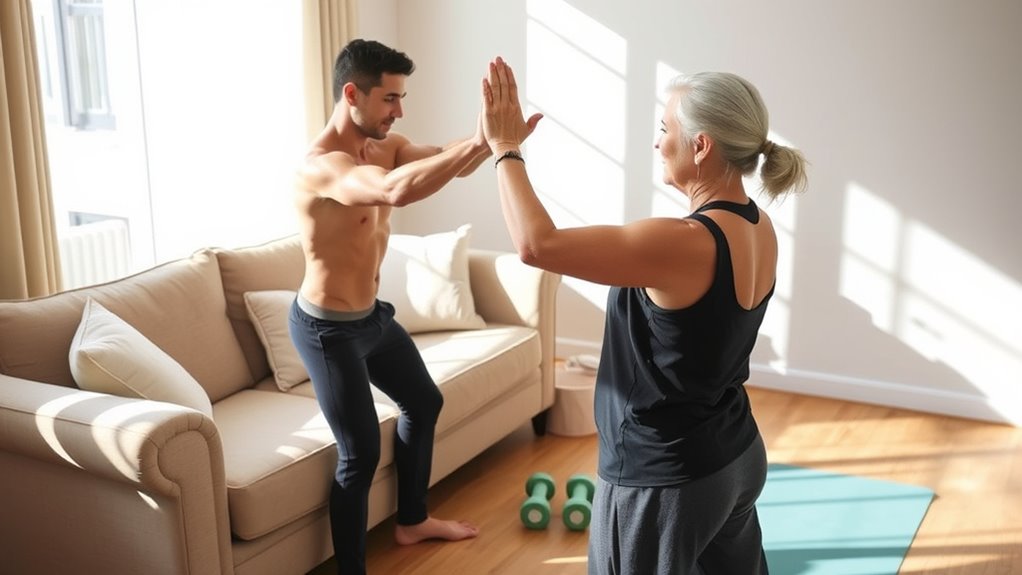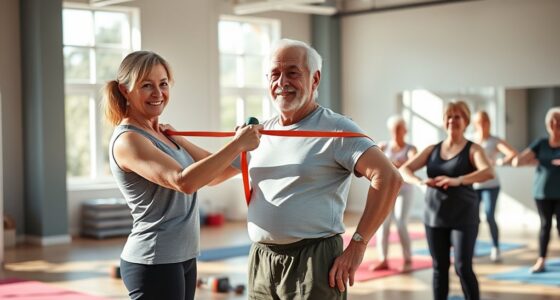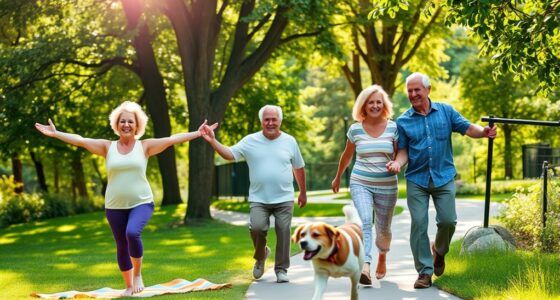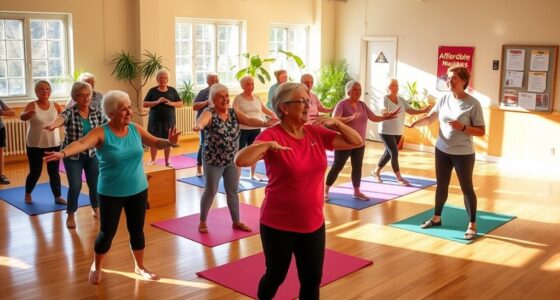In-home personal trainers for seniors can transform your life by creating fitness programs tailored to your unique needs and mobility levels. You’ll engage in safe exercises that enhance your physical health, boost your mental well-being, and promote independence. Training at home offers the convenience you need to maintain a consistent routine while avoiding transportation barriers. Plus, trainers provide the support and motivation necessary for long-term success. There’s much more to learn about how these trainers can benefit you.
Key Takeaways
- In-home personal trainers create customized fitness programs tailored to seniors’ unique needs, ensuring safe and effective exercise routines.
- Regular physical activity with a trainer boosts physical health, enhancing strength, balance, and flexibility while reducing the risk of age-related health issues.
- Trainers provide a convenient and flexible workout schedule, promoting consistency and adherence to fitness goals in the comfort of home.
- Engaging in personalized training fosters social connections and reduces isolation through group sessions and camaraderie among participants.
- Establishing a supportive relationship with a trainer enhances accountability, motivation, and long-term success in achieving fitness and wellness goals.
The Importance of Physical Activity for Seniors
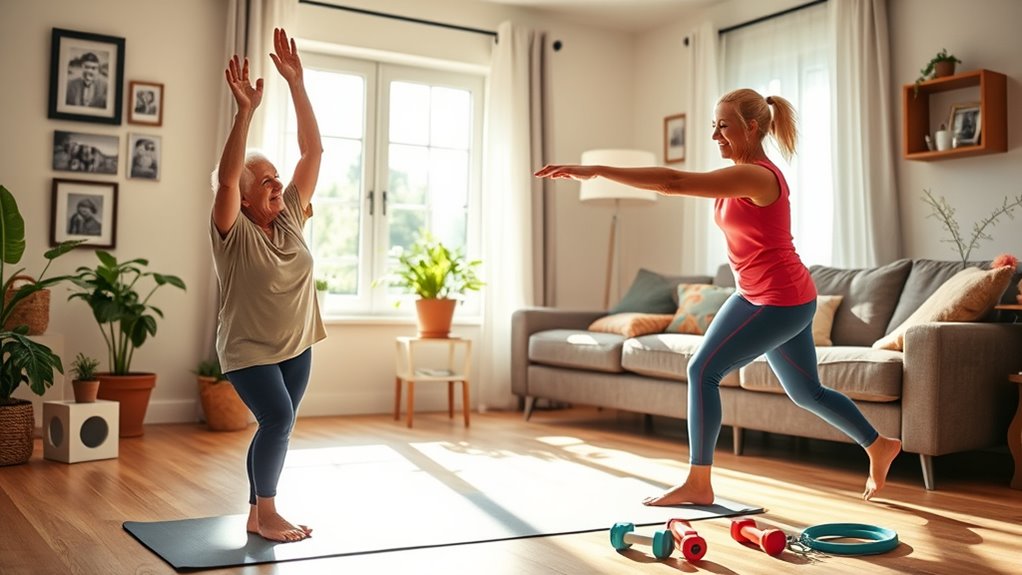
As you age, staying physically active becomes increasingly important for maintaining your health and wellbeing. Regular exercise greatly reduces your risk of heart disease and stroke while helping manage hypertension and improving blood sugar control, which can delay type 2 diabetes. It also lowers the risk of certain cancers and enhances your immune function, vital for seniors. Beyond physical health, staying active boosts your mental and emotional wellbeing by releasing endorphins, which help relieve stress and improve your mood. Additionally, regular physical activity helps prevent disease, further emphasizing the importance of exercise in your daily routine. Engaging in regular exercise can also improve financial considerations for elderly care by potentially reducing healthcare costs associated with chronic diseases.
Staying physically active as you age is crucial for heart health, diabetes management, and overall wellbeing.
Research shows that hydration and nutrition play a significant role in maximizing the benefits of physical activity for seniors, and incorporating multi-functional gear into your routine, such as resistance bands, can enhance your strength training. You’ll find that exercise enhances your sleep quality and increases your self-confidence and energy levels. Furthermore, engaging in activities like gentle yoga stretches can provide relaxation benefits that are particularly helpful as you age, and it can also enhance self-care practices that promote overall well-being. Plus, it fosters social connections, reducing feelings of loneliness. Prioritizing physical activity is essential for a healthier, happier life as you age.
Benefits of In-Home Personal Training
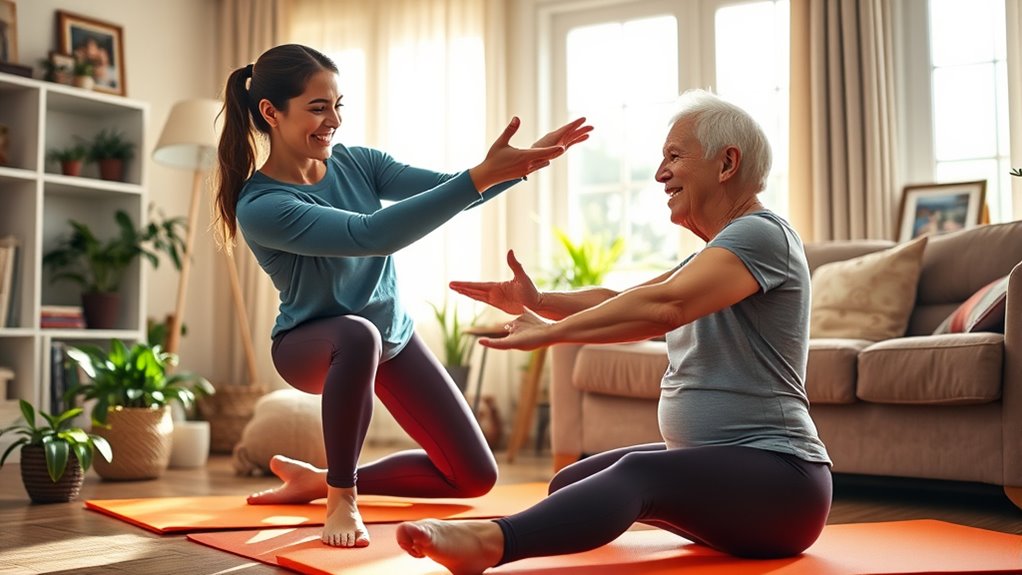
In-home personal training offers numerous benefits that can greatly enhance your fitness journey as a senior.
You’ll receive tailored exercises designed specifically for your needs and mobility levels, helping you achieve realistic goals like improved strength and flexibility. Regular physical activity maintains independence and prevents age-related health conditions, making it essential for seniors to stay active. Additionally, engaging in regular exercise can help manage RMDs and their tax implications, ensuring you stay financially fit as well. Furthermore, creating a comfortable living space can significantly improve your motivation and enjoyment of physical activity. Incorporating exercise routines that focus on flexibility and strength can also enhance your overall well-being. Engaging in outdoor activities, such as camping locations, can provide additional opportunities for physical exercise and social interaction. Implementing data-driven decision-making in your fitness routine can lead to more effective workouts and better results.
The convenience of training at home eliminates transportation barriers and allows you to work out in a comfortable, familiar environment, reducing stress associated with gyms.
With flexible scheduling, you can stay consistent with your fitness routine.
Trainers monitor your form to guarantee safety and provide modifications for any physical limitations.
Regular assessments help track your progress, keeping your workouts effective and relevant.
Advantages of Hiring a Senior-Focused Trainer
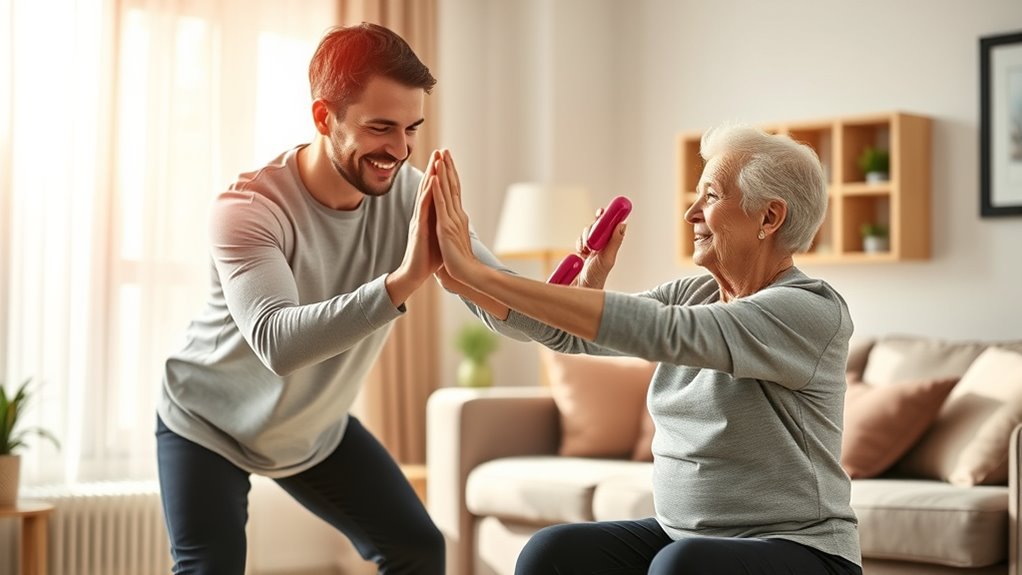
Hiring a senior-focused trainer brings a wealth of advantages that can considerably enhance your fitness experience.
These trainers create customized fitness plans tailored to your unique health needs and goals, ensuring exercises are safe and effective. They adapt workouts based on any pre-existing conditions, such as arthritis, to prevent complications while boosting your strength and flexibility. Additionally, job growth in the fitness industry indicates increasing demand for specialized trainers, ensuring you receive quality instruction. Regular physical activity is essential for seniors to enhance cardiovascular health, further promoting overall well-being. Engaging in exercise can also help reduce obesity risks, which is particularly important for maintaining a healthy weight. Moreover, incorporating advance directives into your wellness plan can provide peace of mind regarding your health decisions as you age. In addition to this, understanding solar energy solutions can also promote a sustainable lifestyle that supports your overall health.
With expert guidance, you’ll learn proper form and technique, reducing the risk of injury in a safe training environment. Trainers also provide motivation, helping you stay accountable and engaged with your routine. Moreover, they ensure safe exercise practices to prevent injuries, allowing you to focus on your fitness journey with confidence.
Expert trainers guide you in mastering proper techniques, ensuring safety while keeping you motivated and accountable in your fitness journey.
As you progress, you’ll gain confidence in your abilities, enhance your mobility, and promote independence in daily tasks, transforming your life for the better.
Key Components of an In-Home Fitness Program
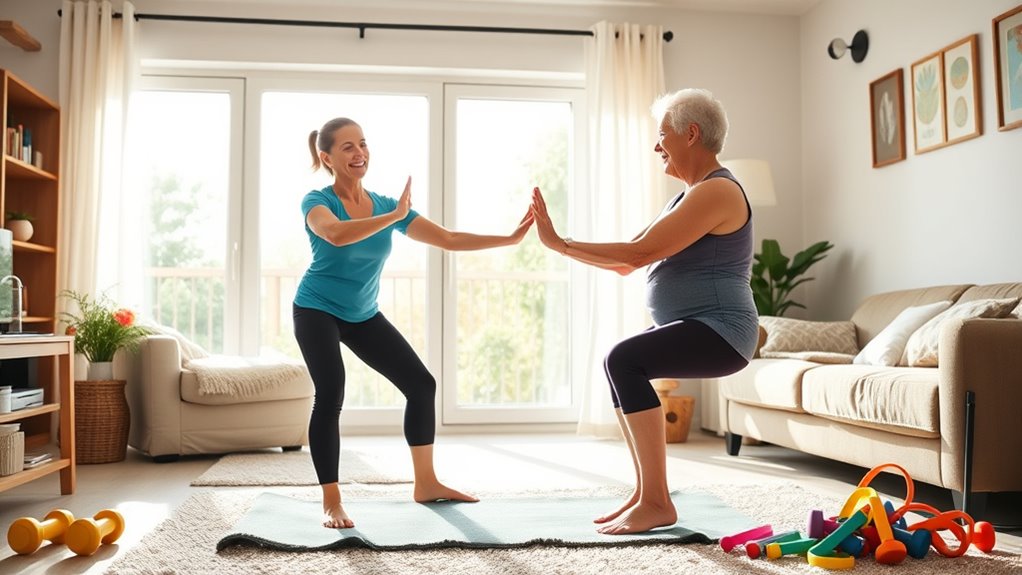
A well-structured fitness program at home can greatly enhance your overall health and well-being. To achieve this, incorporate a mix of aerobic activities, strength training, balance exercises, and flexibility routines. Aim to engage in functional mobility exercises that mimic daily tasks. Supervision from trained instructors can provide guidance and guarantee safety, while educational materials keep you informed. Regular physical activity provides substantial health benefits for older adults, helping preserve function and mobility. Incorporating educational toys into home fitness routines can also enhance engagement and motivation. For instance, using Montessori-inspired toys can make physical activities more enjoyable and interactive. Additionally, consider including omega-3 benefits from dietary sources like chia seeds to support overall health, as they can promote satiety and reduce hunger. To further enrich the experience, consider integrating seniors texting humor into your fitness routine for a joyful and social component. Customize workouts to fit your specific health needs, and use household items as equipment. Schedule sessions two to three times a week for consistency, starting with manageable durations and gradually increasing intensity. Finally, leverage digital technologies for motivation and progress tracking, ensuring you stay connected and engaged in your fitness journey.
Overcoming Challenges in Senior Fitness
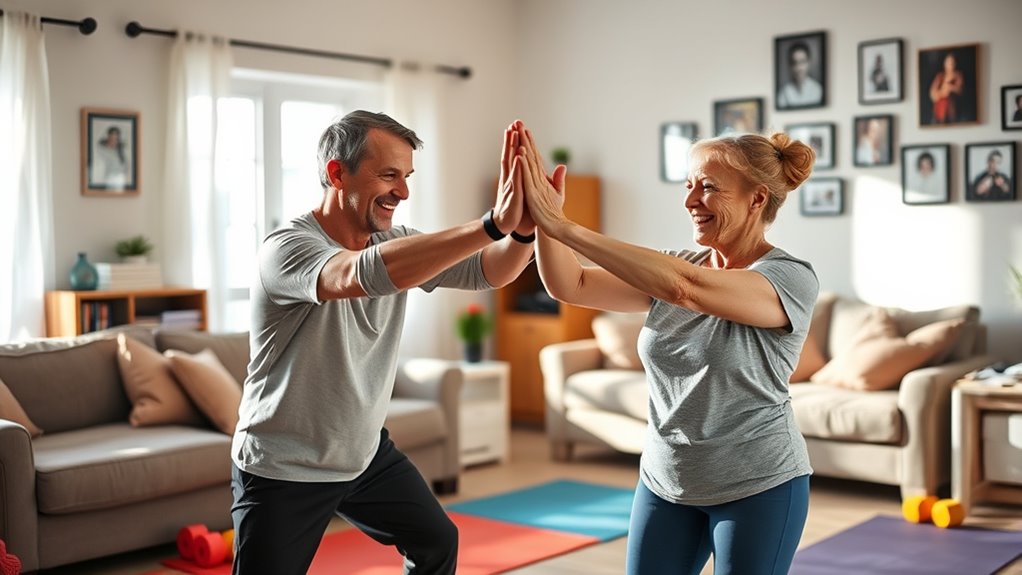
While aging can bring physical limitations and health concerns, overcoming these challenges in senior fitness is entirely possible with the right approach. Many seniors experience reduced muscle mass, joint pain, and mobility issues, but a tailored exercise program can address these concerns effectively. Regular exercise can also provide immediate benefits such as improved sleep quality and reduced anxiety, which are crucial for seniors managing chronic conditions. Additionally, engaging in physical activity can be a key component of good grief, helping to alleviate feelings of sadness and promote emotional well-being. Incorporating mindfulness practices into fitness routines can further enhance self-awareness and emotional resilience. Safety is vital, so working with a personal trainer guarantees proper technique and minimizes the risk of falls. As about 91% of seniors have chronic conditions, addressing health limitations through customized workouts becomes indispensable for managing these issues. Engaging in regular exercise not only boosts physical health but also enhances mental well-being and social connections. Furthermore, creating an accessible home environment can significantly support seniors in maintaining their fitness routines. With holistic approaches to health and wellness, motivation and support can help you embrace fitness and improve your overall quality of life as you age. Additionally, incorporating omega-3 fatty acids into your diet can further support cognitive function and overall health in seniors.
Customized Programs for Individual Needs
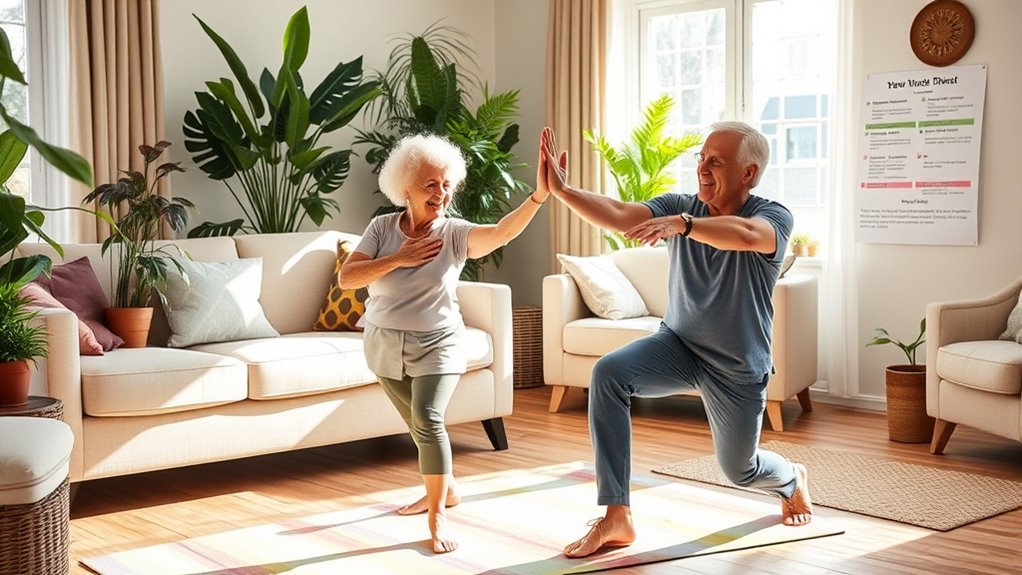
When you choose a customized fitness program, you’re taking a significant step toward addressing your unique needs as a senior. Your program starts with a thorough assessment of your current fitness level, medical history, and personal goals. Trainers carefully consider any existing health conditions, like arthritis or osteoporosis, ensuring exercises are safe and effective. With tailored goals, your routine may focus on improving strength, flexibility, or endurance. Regular exercise can counteract physical function decline, and as you progress, workouts adapt to match your growing fitness levels. This personalized approach not only boosts motivation by aligning with your interests but also enhances adherence, making it easier to maintain a consistent routine. Additionally, engaging in trust-building activities can foster a supportive environment that encourages you to stay committed to your fitness journey. Ultimately, customized programs support your overall well-being and help you stay independent. Furthermore, maintaining physical health through exercise can prevent the effects of narcissistic abuse, which often leads to neglect and emotional turmoil. By embracing continuous learning and skill development, you can further enrich your fitness journey and overall quality of life. Moreover, utilizing predictive modeling can help trainers understand how to best support your evolving fitness journey and anticipate your future needs. Additionally, maintaining a routine can provide emotional stability for seniors, which is essential for overall health and well-being.
Enhancing Mental Well-being Through Exercise
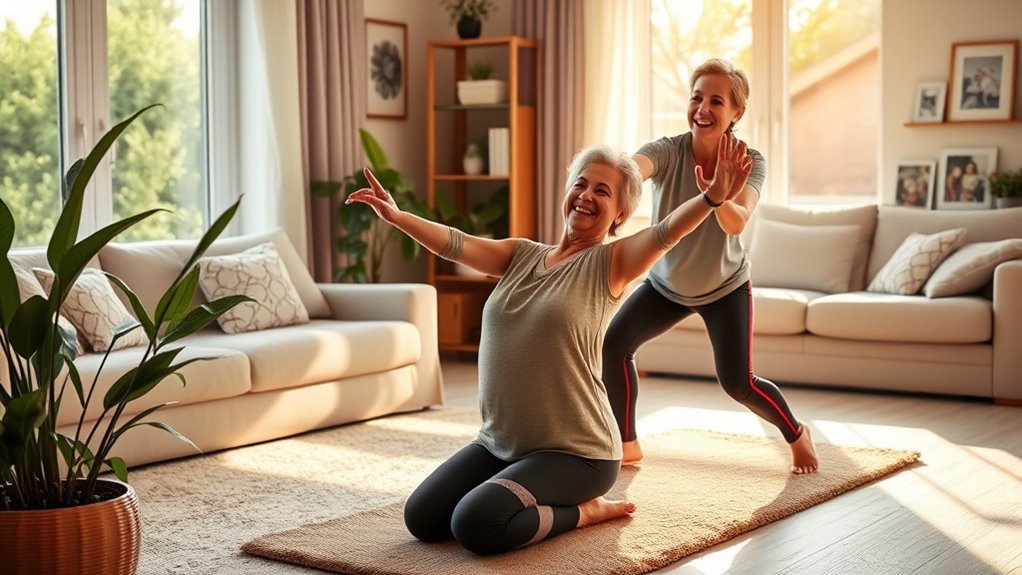
Exercise isn’t just about physical fitness; it plays an essential role in enhancing your mental well-being, too. Regular physical activity can reduce symptoms of depression and anxiety, helping you feel more balanced. It also improves your sleep, which is crucial for mental clarity. As you engage in exercise, your brain releases endorphins, boosting your mood and providing a healthy outlet for stress. Furthermore, consistent routines can enhance cognitive function, improving your memory and focus. Engaging in physical activities creates opportunities for social interaction, reducing feelings of isolation. Regular physical activity increases overall mental well-being, making it an essential component of a healthy lifestyle for seniors. Additionally, regular exercise can contribute to better credit scores, which may alleviate financial stress and enhance overall well-being. Moreover, engaging in physical activities can help seniors maintain a healthy weight, reducing the risk of obesity-related conditions. Whether it’s aerobics, strength training, or yoga, these activities not only promote physical health but also greatly enhance your overall quality of life and mental resilience. Moreover, vibrational alignment with positive feelings during exercise can amplify its benefits, creating a powerful synergy for mental health improvement.
Safety and Injury Prevention in Home Training
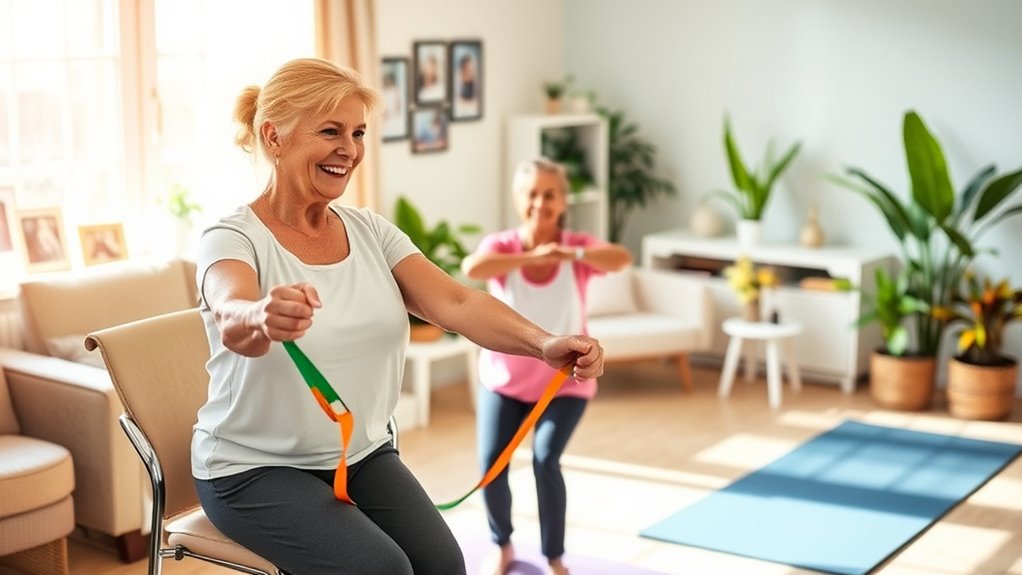
Ensuring safety during in-home training for seniors is crucial, as it helps prevent injuries and promotes a positive exercise experience.
Personal trainers customize workouts to accommodate your health conditions and physical limitations, ensuring you don’t overexert yourself. They assess your home for hazards, suggesting modifications like non-slip mats and grab bars to reduce fall risks. Incorporating strengthening and balance exercises is essential for enhancing muscle function and stability.
Emphasizing proper technique, trainers help you maintain strict form, minimizing injury chances. They also adapt exercises to suit your abilities and monitor your progress, adjusting as you improve.
Achieving Independence Through Fitness
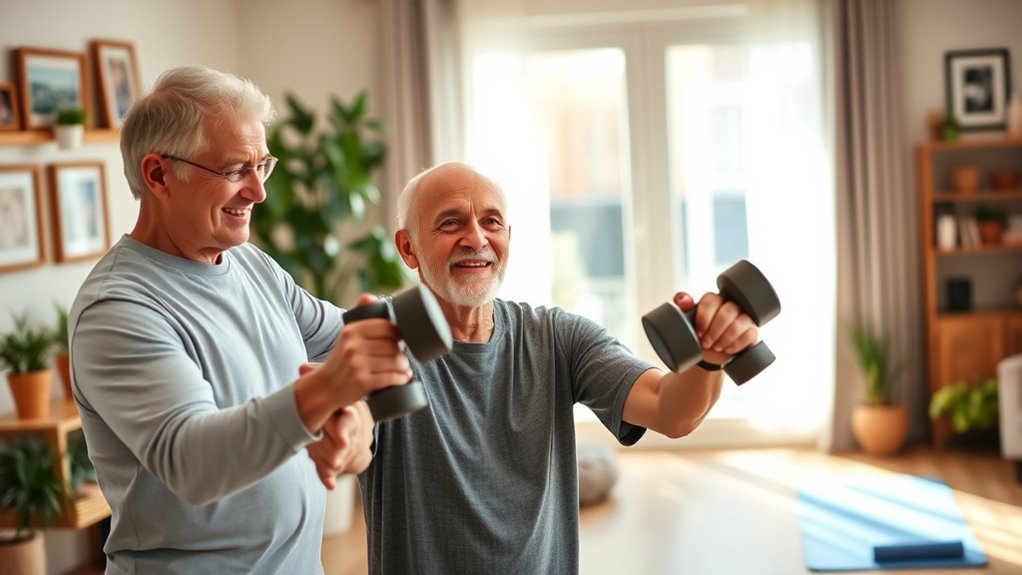
Achieving independence through fitness isn’t just about physical strength; it’s about empowering you to perform daily activities with confidence. Customized fitness plans address your specific needs, ensuring safe and effective exercises that enhance your strength, balance, and flexibility.
As you set goals and monitor your progress, you’ll feel more motivated and accountable. Regular workouts strengthen your cardiovascular health, improve bone density, and boost your immune system, all of which contribute to your overall wellness. Additionally, incorporating nutritional guidance into your fitness routine can further support your health and enhance your exercise efforts.
Additionally, exercise releases endorphins, improving your mental well-being and reducing stress. With personalized training, you’ll maintain muscle mass, reduce fall risks, and build the stamina necessary for independent living.
Ultimately, fitness not only supports your physical abilities but also your confidence in leading a fulfilling life.
Building Lasting Relationships With Trainers
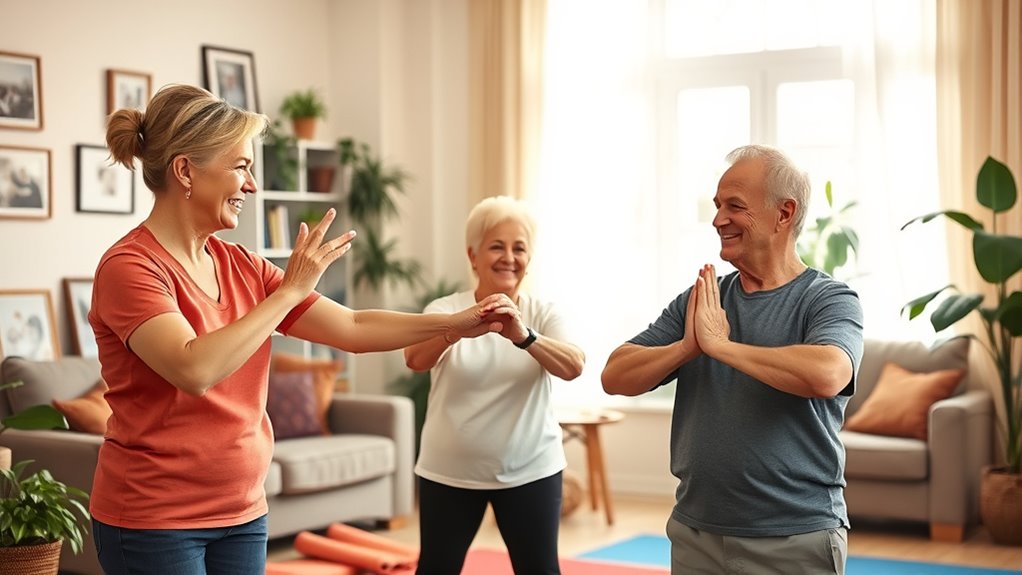
When you work with a personal trainer, you’re not just getting guidance for your workouts; you’re building a supportive relationship that can greatly enhance your fitness journey. Your trainer fosters trust and provides a safe environment, especially if you have health concerns. They encourage you, helping you stay committed to your goals while tailoring programs to fit your unique needs. This personal connection can combat feelings of loneliness, as trainers often facilitate group sessions, promoting social interaction. With consistent support, your trainer keeps you accountable, ensuring you stay on track. These lasting relationships not only improve your fitness but also contribute to a more fulfilling and active retirement, making every workout a step toward a happier life. Additionally, trainers often focus on enhanced balance and coordination, which is critical for maintaining independence as we age.
Frequently Asked Questions
How Much Does In-Home Personal Training for Seniors Typically Cost?
In-home personal training costs for seniors typically range from $30 to $100 per session, depending on your location and the trainer’s experience.
While private sessions offer personalized attention, they tend to be pricier than group sessions.
If you’re looking to save, consider booking multiple sessions at once for discounts.
Keep an eye out for special offers or referral discounts that trainers may provide to new clients, helping you get the best value.
What Qualifications Should I Look for in a Senior-Focused Trainer?
When searching for a senior-focused trainer, you might wonder if they truly understand your unique needs.
Look for specialized certifications, like ACE Senior Fitness or NASM Senior Fitness Specialist. Make sure they’ve got current First Aid and CPR certifications, too.
Their experience with seniors is essential—without it, how can they adapt exercises for you?
Finally, seek someone patient and encouraging; that supportive attitude can make all the difference in your fitness journey.
How Often Should Seniors Train With a Personal Trainer?
You should aim for strength training at least twice a week, combining it with moderate aerobic activities for 150-300 minutes per week.
If you have specific goals, consider training 3-4 times weekly for better results.
Incorporating balance and flexibility exercises at least twice weekly is essential to enhance your overall mobility and functional strength.
Consistency is key, so finding a routine that works for you’ll help maintain your independence and well-being.
Can Personal Trainers Help With Nutritional Guidance for Seniors?
You might think personal trainers can’t assist with nutrition, but they actually can provide valuable guidance.
They can help you understand the importance of whole foods, protein intake, and avoiding nutrient deficiencies.
While they can’t prescribe meal plans, trainers customize advice based on your health goals.
This tailored support can motivate you to maintain a balanced diet, enhancing your fitness journey and overall well-being as you age.
What Equipment Is Needed for In-Home Training Sessions?
For in-home training sessions, you’ll need some essential equipment to maximize your workouts.
Start with resistance bands for strength and flexibility, and an exercise mat for comfort during floor exercises. Light dumbbells can help you build muscle without strain.
Consider a recumbent exercise bike for low-impact cardio, and stability balls to improve your balance.
Finally, foam rollers are great for muscle recovery.
This setup will keep your sessions effective and enjoyable!
Conclusion
In-home personal training can truly transform your life as a senior, enhancing not just your physical health but also your mental well-being. Imagine Mary, a 70-year-old who struggled with mobility and motivation. After just a few months with her dedicated trainer, she’s not only regained her strength but also built a friendship that keeps her looking forward to workouts. By investing in your fitness, you can achieve independence and enjoy a more vibrant, fulfilling life.
